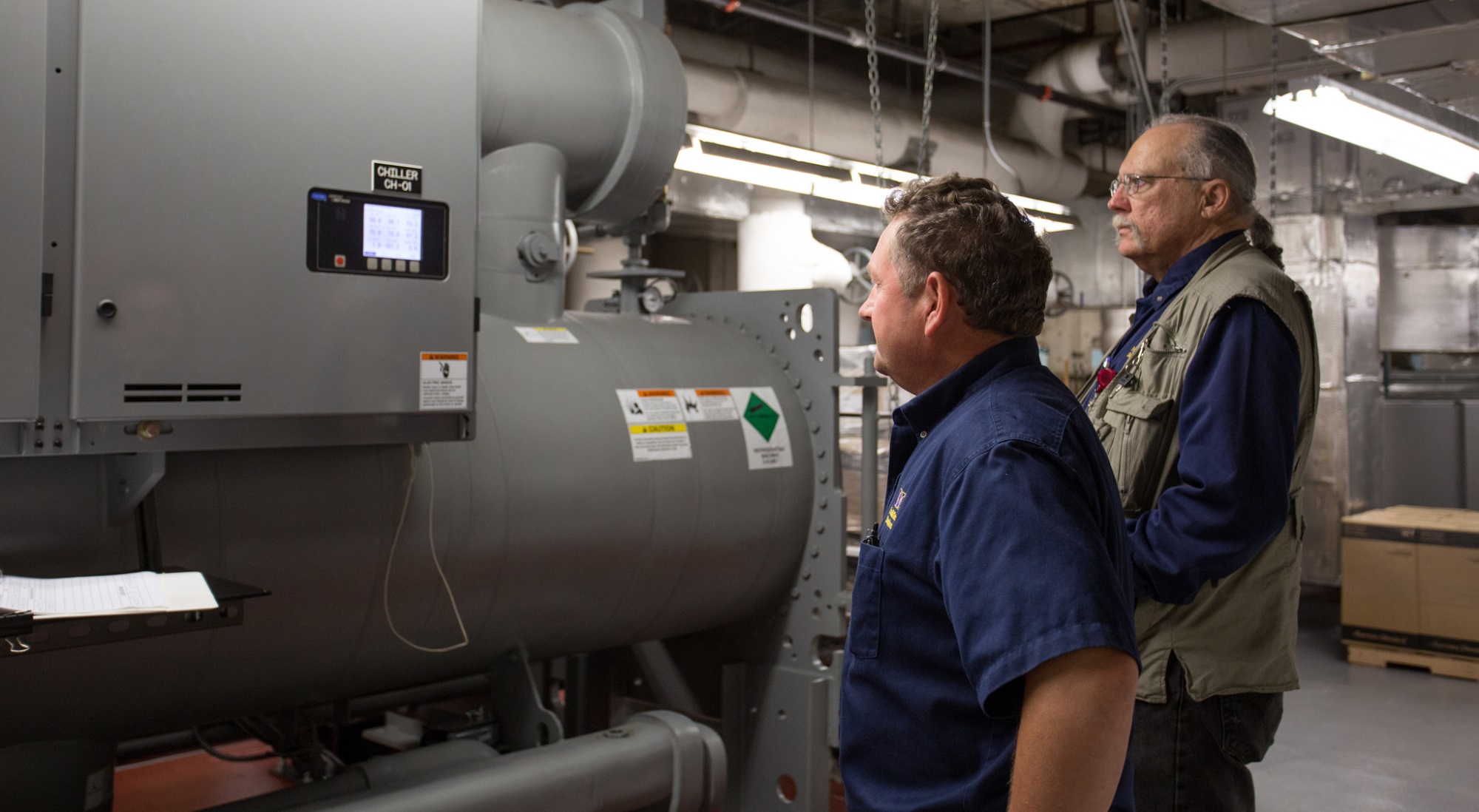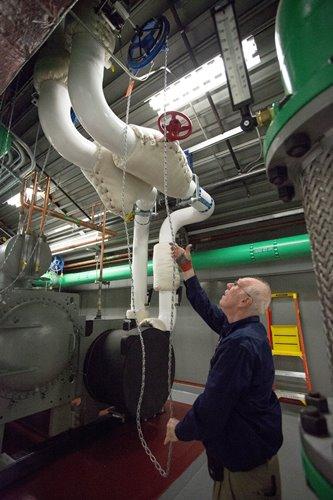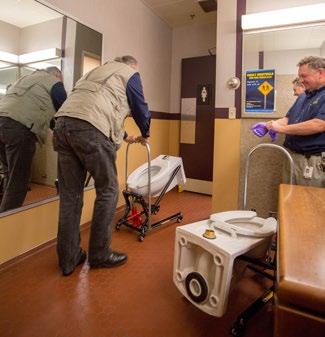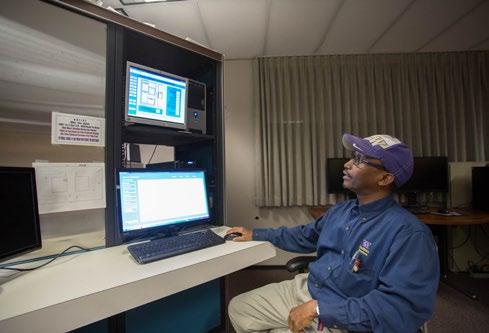UW Tower Night Owls

Above, Peter Gorokhovskiy shows off his favorite tower view, just after sunset from the rooftops of UW Tower.
The UW Tower second shift includes Peter Gorokhovskiy and Eric Johnston, and the third shift includes David Record and Adam Diriye. The second shift is sometimes joined by Mike Craig, providing audio/visual support to events.
The tower was purchased by the University of Washington from Safeco in 2007, and with it came a dedicated staff of around-the-clock maintenance workers.
“I came with the building,” quipped UW Tower Manager Troy Swanson.
The tower’s crew of evening and overnight Facilities Operations Maintenance Specialists (FOMS) have all been here for at least 10 years, with many of them pushing 30 years on the job.
“There’s no uncertainties in our work,” said overnight specialist Adam Diriye. “We know this building inside and out. We know every piece of machinery and all about every task we could possibly have to do.”
And not only are they in-tune with the building’s quirks, they’re passionate about the work they do.
“Sometimes I feel like the tower’s my child. It needs a lot of attention, and I’m here to take care of it,” said overnight specialist David Record. “I’m really proud to work for the University of Washington. I put on my uniform with pride when I arrive every night. I just love to talk about the amazing things going on at the University that I get to help support in this job.”
David Record turns on valves before starting up the building’s chiller, just before employees return to work in the morning.

Peter Gorokhovskiy and Eric Johnston check on the tower’s chiller system during an after-hours event. After, they install new lowflow toilets in Advancement’s restrooms.
WHY NIGHTS?
WHY NIGHTS?
The tower has two evening shifts, second shift, which runs from 3:30 to 11:30 p.m., and third shift, which runs from 11:30 p.m. until 7:30 a.m. the next day. Second shift workers help shut the building down after University employees have left for the day. Third shift workers help bring it back to life in the mornings, before the tower’s 1,800+ employees arrive for the workday.
“I like how calm evenings are. Nothing’s a rush, and most everything is routine. I like the calm and being able to focus on what I’m doing without getting distracted or flustered,” said Record. “I also really like how when I’m off work, I am free during the day! I can go to appointments and enjoy the sunshine. Traffic is lighter when I’m commuting, and when I leave, and parking is less expensive. On night shift we also get paid a little more. I really enjoy being on third shift.”
For his third-shift partner, nights were what was available when he applied.
“When I started working, night shift was the only shift available, so I took it. But I’ve grown to really like it,” said Diriye. “David had been working here for 30 years when I started, so he gave me a lot of encouragement. He’s worked at it as a career, and I can do that too.”
For the second shift workers, from the afternoons until 11:30 p.m., they like evenings for the same reasons.
“I really like the structure of night shift. I get to work more on projects without being called away to other immediate problems,” said Eric Johnston. “I’m not spending my time putting out brushfires all day, we’re working on longer term projects, like upgrading all of the tower’s toilets to low-flow fixtures. We just go in and do it! That’s the beauty of night shift. There’s nothing in our way.”
SWING SHIFT HIGHLIGHT: UW TOWER EVENTS
SWING SHIFT HIGHLIGHT: UW TOWER EVENTS
The FOMS crew isn’t the only one in the building after most of the tower’s employees have left for the day. Media maintenance technician Mike Craig provides assistance for all of the tower’s after-hours events, in addition to working during the days.
“The people putting on the events rent me out just like they do the space,” said Craig. “I help set up microphones, video feeds, slide decks, computers and speakers.”
When he’s not handling the tower’s many events, such as conferences and lectures, he’s providing A/V support for the entire building.
“There’s always more cameras and A/V equipment to install somewhere,” said Craig.
PROJECTS
PROJECTS
Currently the sustainability-conscious tower staff are working on installing low-flow toilets and urinals throughout the building, replacing hundreds of older water-hogging fixtures. But when the four evening and overnight FOMS employees aren’t working on this project, they’re responding to requests and work orders from the employees who work in the tower every day.
“If it’s your problem, then it’s also our problem,” said Johnston. “Our customers’ needs are our most pressing needs. Until those problems are solved, then it’s the most important thing in our minds.”
“We’re here to make people happy,” said second shift specialist Peter Gorokhovskiy. “When we get a work order about a particular issue, we always say ‘no problem’ and come up with a fix.”
The night staff also comes up with improvements for how to do their work. “I do a lot of curtain repairs and repairs that involve shutting down plumbing or electrical systems, so I had this idea to use the building’s floorplans to keep track of lighting changes and curtain types,” said Record. “It makes it faster to go out to a floor and make a change, we can go right out to the location that needs to be fixed instead of hunting around for it.”
THE ISLAND
THE ISLAND
In a way, the UW Tower is a bit like an island. The Tower has its own dedicated crew of Facilities Operations Maintenance Specialists (FOMS), its own equipment, and its own quirks. It’s the same size as the UW Bothell or UW Tacoma campuses.
And it takes a dedicated crew of around-the-clock staff to keep this campus-within-a-campus running.








